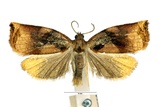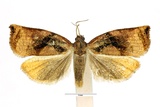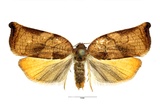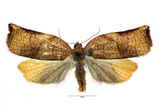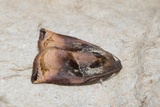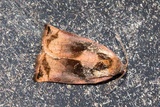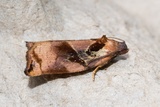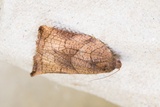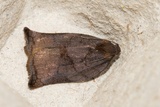Archips podana (Scopoli, 1763) Species
Last modified: Oct. 2, 2025, 1:38 p.m.
A common species throughout Belgium.
Details
- Classification
- Family: Tortricidae > Subfamily: Tortricinae > Tribus: Archipini > Genus: Archips > Species: Archips podana
- Vernacular names
- Grote appelbladroller (NL), Large Fruit-tree Tortrix (EN), la Tordeuse de l'osier (FR), Bräunlicher Obstbaumwickler, Fruchtschalenwickler, Eschenzwieselwickler (DE)
- Synonyms
- Archips pyrastrana (Hübner, 1799)
- First mention in Belgium
- De Fré Ch. 1858. Catalogue des Microlépidoptères de la Belgique. — Annales de la Société entomologique belge 2: 45–162. On page 67.
- Status
-
Native
Distribution
Imago
Wingspan 18–26 mm. A sexually dimorphic species. The male forewing is pale purplish brown with a dark-brown basal patch and well-defined median fascia. The female forewing is pale brown to purplish brown with darker reticulate markings. The hindwing in both sexes is gray basally and yellowish orange apically, the yellowish-orange coloration is usually more pronounced in the female. Dark forms of both sexes exist, where the entire forewing is overlaid with purplish-gray scaling. Males have a forewing costal fold.
Egg
Eggs in masses of 50-100 individual eggs on the surfaces of leaves, they are covered by a waxy secretion that both protects and camouflages the egg mass.
Caterpillar
Last instar larvae are approximately 15–20 mm in length. The abdomen is pale green to pale gray with pale conspicuous pinacula. The head is reddish brown. The prothoracic shield is reddish brown anteriorly and shaded with black posteriorly, a thin white line on the anterior margin of the shield separates it from the head. Thoracic legs are brown or black.
Bionomics
Second and third instars feed on the surface of fruit, often creating a shelter by webbing leaves to fruit. Larvae overwinter in the third instar and continue development the following spring. Fourth instars feed on developing buds and subsequent instars feed on foliage in shelters constructed of webbed leaves. Pupation occurs in the final larval shelter. Sometimes becoming a pest in orchards.
They are mainly active at dusk and later come to light.
Flight periods
The adults fly usually from late May till late September/October.
Observed on
- Substrates:
- Polyphagous
A polyphagous species on trees and shrubs like Corylus, Fagus, Malus, Pyrus, Quercus, Rosa, Ribes, Vaccinium, Trifolium, Alnus... and sometimes also Picea.
